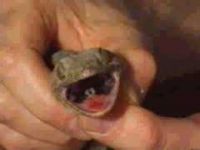| This article is still under construction. |
Lungs
The lungs are simple sacs with internal folds for an increased surface area, unlike the more complex structure of mammalian lungs. The trachea divides into two bronchii which open into the lungs without bronchioles. Respiration, which is voluntary and dependant on blood carbon dioxide pressure and temperature, is aided by expansion and contraction of the ribs as lizards lack a diaphragm.
In many lizards gas exchange occurs in the cranial part of the lung, while the caudal portion of the lung is analagous to the avian air sac.
Nares
Nasal salt glands are present in herbivorous iguanid lizards such as the green iguana. These excrete excessive sodium and potassium when the plasma osmotic concentration is high. Lizards achieve this by sneezing, which expels a clear fluid that dries to a fine white powder consisting of salts. This mechanism should not be mistaken for a upper respiratory infection as it is a normal physiologic process allowing water conservation. Located anterior in the roof of the mouth, the paired internal nares are a common site for discharges to accumulate and therefore a good sampling site for bacteriology when a respiratory infection is present or suspected.
Glottis
The hard palate is reduced to allow airflow from the inner nasal opening to the glotttis. The glottis is generally quite rostral and located at the base of the tongue. It is normally closed except during respiration. This simplifies intubation and tube-feeding.
References
- Mader, D.R. (2005). Reptile Medicine and Surgery. Saunders. pp. 1264. ISBN 072169327X
